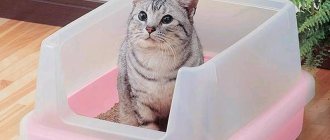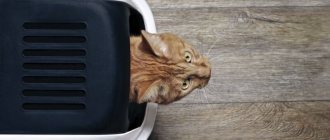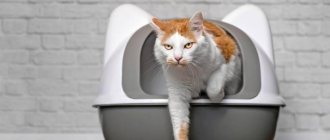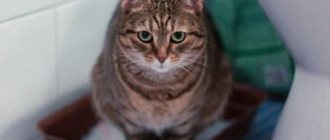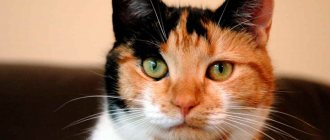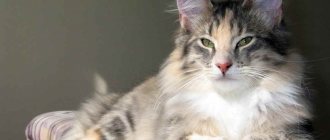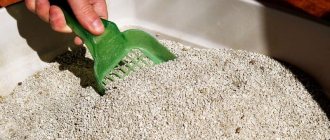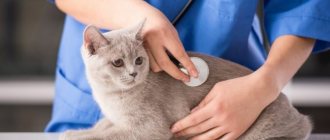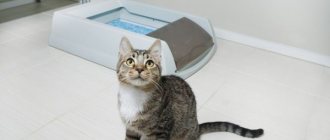Often cats suddenly develop health problems, and the owner does not know what to do or how to help the pet. If the cat cannot go to the toilet in a small way, then, of course, you need to quickly contact a veterinarian. In our article we will try to explain in more detail the problems of this disease, what the causes of this condition may be, and how to provide all possible help to your pet.
How to tell if your pet has urinary problems
If a cat cannot go to the toilet in a small way, then it will be difficult not to notice, because she moans loudly, meows, and screams in a voice that is not her own. When she does manage to urinate, very little urine comes out. The pet can come up to its tray, stomp next to it, and snuggle up to it. It’s as if he doesn’t dare to go into it; in fact, the cat is trying to help himself go to the toilet to urinate. He does not allow you to touch his bloated belly, like a drum, which is very painful. The pet cannot lie on its tummy. Sometimes there are traces of pus or blood in the tray.
How to help your cat: treating constipation
Before you find out how to treat constipation in a cat, you need to confirm the diagnosis itself, and only a qualified veterinarian can do this. And the point is not even to understand whether the cat is definitely constipated; you can figure this out yourself. The point is that treatment of constipation must be done carefully and consistently, first of all by identifying and eliminating its cause.
An initial examination and tests will help the veterinarian understand how to help the animal, as well as give you competent recommendations for home treatment. It is worth understanding that using folk remedies for treatment on your own is not only ineffective, but also very dangerous.
Do not underestimate the seriousness of the problem and assume that a regular laxative or its analogues will be enough, because the digestion of humans and cats has several serious differences.
If parasites are active, the doctor will prescribe you the appropriate medications and a specific diet, since the animal’s nutrition in any case will need to be monitored very carefully. If we are talking about an infectious or viral disease, it will be necessary to deal with them initially, and if adhesions or intestinal obstruction are detected, urgent surgery may be required.
Formation of a proper diet
Nutrition is one of the main factors that will need to be taken into account in the future. The animal will need a specific gentle diet. There are specialized veterinary foods for constipation; they contain an increased amount of fiber, which stimulates the functioning of the stomach and intestines. Of course, this is not a full-fledged treatment, but it is worth starting with this and in the future also try to give the animal a sufficient amount of vegetables, grains and dairy products, without overdoing it too much, so as not to provoke constant flatulence. In general, the veterinarian will tell you what to feed your cat and how long to adhere to a similar diet, since for different diseases diets may differ, and in the case of operations, a separate diet is prescribed.
Vegetable oil
Vegetable oil generally promotes better intestinal function and helps the animal go to the litter box without problems. At the same time, you should not overdo it with its use, and especially use it regularly, since it seriously loads the animal’s liver, which is much more vulnerable than that of humans. It is for this reason that sunflower oil should not be given to old, pregnant or sick cats. The recommended daily dose is only a few grams, so a couple of drops added to food will be more than enough.
Laxative
Often, laxatives are used as the main method of treatment, but it is important to understand that such drugs cannot be used independently, as they have a strong effect. If the animal has no contraindications, then it is important to correctly calculate the dose, as well as give the animal auxiliary drugs that improve intestinal microflora. The veterinarian will calculate the dose depending on the current condition of the pet, its weight and age. He will advise you on the best medications and also indicate the number of uses.
Using enemas
Many people believe that an enema is the best remedy for constipation, but in the wrong hands it can easily cause more harm to the animal than good. If you choose the wrong temperature or volume of liquid, you will cause the animal serious discomfort and real pain. It is equally important to regulate the pressure correctly, and only an experienced specialist with relevant experience can competently perform such a task. That is why veterinarians warn owners of animals, especially small ones, to refrain from using enemas, and at a minimum not to do so without prior consultation.
Vaseline oil
Vaseline oil effectively coats the intestinal walls, softens stool and is generally an excellent painless remedy against constipation. However, like other oils, it negatively affects the animal’s liver, and therefore it must be used after consultation with a specialist who will accurately calculate the dose based on the characteristics of the cat, its size, breed, age and condition. Of course, using Vaseline and, for example, castor oil at the same time is strictly prohibited, because such combinations can ultimately lead to acute liver failure.
What can cause such a condition?
Many owners of mustaches are interested in why problems with urination occur? Your pet rarely goes to the toilet for several reasons:
- Low urine output can be caused by insufficient fluid intake. A small amount of urine contains a high concentration of salts, from which stones subsequently form.
- Hereditary factor. If a cat has had similar diseases in its family, then it is more likely to have problems with urination than those animals whose heredity is not burdened with such issues.
- Physiological features. There are cases when a kitten is born with a urinary tract obstruction. This issue can only be resolved surgically.
- Improperly managed cat nutrition can lead to heavy urination. Excessive consumption of raw meat and fish, salty and mineral foods can provoke this problem.
- A cat may rarely go to the toilet if he is overweight. As a rule, such pets lead a sedentary lifestyle, which can cause poor urine flow.
- This reaction occurs after suffering stress. This could be a sudden move, a change of owner, or a trip on public transport.
There is an opinion that cats that eat dry food are more likely to develop urolithiasis. However, this is a misconception; on the contrary, dry food is a more balanced source, the main thing is that the cat always has fresh water available.
Is it dangerous for a cat to stop peeing?
If your cat stops urinating, it can be very dangerous. Any form of urinary tract blockage can lead to permanent kidney problems and can even be life-threatening. Because of this, you should always call your veterinarian if your cat hasn't peed in 24 hours. In most cases, you will be advised to come right away.
© shutterstock
It's always better to call a veterinarian sooner rather than later. The sooner your cat can be treated for health problems, the faster he will recover.
Do not try to express your cat's bladder yourself - this can be very dangerous for your pet. Large bladders due to blockage can “burst” at the slightest pressure, leading to death.
What can be done to alleviate the pet's condition?
Of course, when a cat cannot urinate, it is necessary to urgently take him to the veterinarian, but if this is not possible, then you can put a heating pad on the pet’s perineum and stomach.
Under no circumstances should you massage your cat’s tummy; these actions can only worsen your pet’s condition.
First and urgent aid is to insert a catheter to drain urine. This is a difficult and rather painful procedure and should only be carried out by a qualified specialist, and there are often cases of placing a catheter under general anesthesia. During catheterization, the bladder is washed with antiseptics. Frequent catheterization should not be performed because this procedure leads to swelling of the urinary tract, and as a result, the cat will not be able to urinate. Next, the veterinarian will determine the cause of this condition and prescribe treatment.
Diagnostics
After emergency measures are taken, the cat must undergo the necessary diagnostic procedures to identify an accurate diagnosis and prescribe the necessary treatment. Typically, a urine test is taken from the animal and an ultrasound scan of the abdominal organs, kidneys and bladder is performed.
Where to go for help
You can call us at the veterinary office. We employ experienced specialists who are well versed in their field, and they will definitely help your pet. Our own laboratory allows us to obtain examination data within an hour, and modern equipment makes it possible to carry out complex emergency operations. With our surgeon, your cat is in good hands. Come, call or leave requests on the website - we won’t leave you in trouble!
POLAR BEAR
The veterinary clinic in Nizhny Novgorod "White Bear" provides all types of services for cats and dogs.
Conducts any examinations and tests in its own veterinary laboratory; the clinic operates a veterinary ambulance for animals and a 24-hour veterinarian is on call at home. Agreement on the processing of personal data
Public offer
SITE MENU
- About the clinic
- Price list for veterinary clinic services
- Treatment
- Services
- Price list for veterinary clinic services
- Vetapteka
- Contacts
- Site Map
CONTACTS
- Nizhny Novgorod st. Vyatskaya 7
- 8 (831) 437-25-27
- [email protected]
Treatment
If a cat does not walk for several days or does so rarely, then a large number of microorganisms multiply in his bladder. At first, the cat should be in a hospital so that stagnant urine can be professionally removed. Using injections, fluid is administered to the pet to eliminate dehydration. The veterinarian also prescribes antispasmodic drugs to help relieve pain and relax the urethra. Antibiotics and antibacterial agents are usually used to help relieve inflammation in the bladder. After treatment, the cat is discharged home, where all care falls on the owner.
Corrective diet
If a cat is susceptible to urolithiasis, then it needs a corrective diet. It is necessary that the food be rich in vitamins B6, A and glutamic acid. Food should not contain salt and minerals, namely:
- The cat should have a complete exclusion of salty foods.
- Raw fish and meat are prohibited.
- The consumption of all types of fish is excluded. Phosphorus, found in any type of fish, is deposited as an excess mineral in the bladder and leads to the formation of stones.
- Milk should not be consumed by a pet with urinary problems. The point is the increased magnesium content, which will lead to even worse urine flow.
- Pork is too fatty meat, it will lead to thickening of urine, which will further complicate its outflow from the bladder.
The cat should eat special dry food, balanced for animals with problems in the genitourinary system.
Risk categories
Problems with urination often occur in cats that have undergone castration as children. There are cases when urinary retention occurs in kittens, but according to statistics, adults most often suffer from this condition, especially in cats. If a newborn kitten has a problem with urine discharge, then the reason, as a rule, lies in congenital mechanical obstruction of the urinary tract.
How much water should cats get?
When cats eat raw meat, a sufficient amount of water enters the urinary system. Water flushes out minerals and crystals, keeping your bladder and urethra healthy. True, a small amount of crystals in the urine of any species is normal. If the body receives water in the required quantities, minerals and crystals are regularly eliminated, which prevents the formation of stones in the urinary tract.
Common prey for cats in the wild are mice, lizards or small birds. They consist of approximately 75% water. The average water content of dry food is 8%. Cats that eat dry food drink more water than those that eat meat. But if you add up the fluid intake from all sources, that is, from food and directly from drinking water, it turns out that cats that eat dry food receive much less water than cats that eat raw meat or canned food. Cats on a dry diet are more or less in a constant state of dehydration.
Preventive measures
It is quite difficult to cure the reason why a cat cannot urinate; out of 10 cases there will be 9 obligatory relapses. To alleviate your pet’s condition, preventive measures are important:
- Avoid overcooling your cat. The pet should not lie in a damp place, on concrete; if he wants to soak up the sun, it is better to do this on a warm blanket.
- Timely vaccination will lead to fewer diseases, which means fewer microorganisms will enter the cat’s body.
- A well-designed diet for an animal helps to avoid recurrences of inflammatory conditions in the animal’s genitourinary function. It is necessary to completely exclude all prohibited foods. Even once using a prohibited product can cause a relapse.
- Drinking plenty of fluids helps flush out your pet's bladder. Moreover, the water must be fresh and clean, and always be freely available to the animal.
- There is a special dry food available for sale for cats with disorders of the genitourinary system.
Unfortunately, it is impossible to completely cure urolithiasis in a cat. A caring owner should surround the pet with attention, regular preventive examinations, constant use of medications and a balanced diet. Such measures will help the cat lead a normal life.
What to do?
If urinary dysfunction is definitely caused by stress, you should try to minimize it by giving your pet more attention and support, which is no less important for a cat than for a person.
If the cat does not like the new tray or filler, you need to return to the proven model of the tray and granules with the usual texture.
In all other cases, when the presence of a disease is evident, it is best not to try to self-medicate and contact a veterinarian as soon as possible to establish an accurate diagnosis and select the appropriate treatment.
